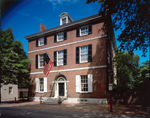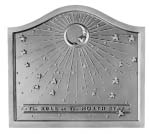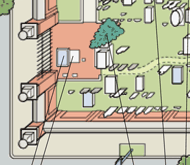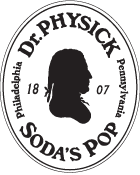

THE UNIVERSITY OF PENNSYLVANIA
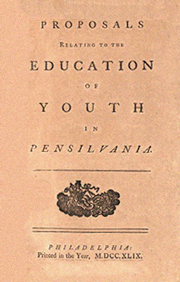
Proposals Relating to the Education of Youth in Pensilvania Philadelphia, 1749
Benjamin Franklin, having had success in founding institutions that benefited the citizens of Philadelphia, was eager in 1749 to create a college to educate the cities future generations. Franklin presenting his vision of a school he called the "Publick Academy of Philadelphia," by publishing a pamphlet titled "Proposal Relating to the Education of Youth in Pensilvania." The pamphlet advocated a revolutionary concept of higher education by proposing an education that taught both the standard ornamental knowledge of the arts, and the practical skills necessary for making a living.
At this time there were only four colleges in existence in the English Colonies, Harvard, William and Mary, Yale, and Princeton. These were all schools for educating the clergy rather than preparing students for careers in business and public service. On November 13, 1749, Franklin assembled the first meeting of a board of twenty-four trustees and charged them with finding an affordable way to build a campus for the Academy of Philadelphia. Dr. Physick's grandfather, silversmith Philip Syng was one of those founding trustees, serving the Academy from 1749 to 1773.
In 1750 the "New Building" at Fourth and Arch Streets, the largest building in Philadelphia, stood unfinished. Begun ten years before as a preaching hall for evangelist George Whitefield, and to serve as a charity school for "the instruction of poor children," construction had stopped due to insufficient funds and the school closed. This was seen by the Academy's trustees as an opportunity to open their school quickly and inexpensively.
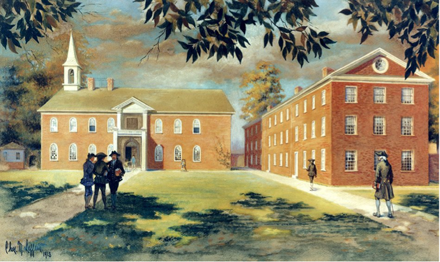
Academy of Philadelphia watercolor by Charles M. Lefferts, 1913
In January of 1751 the Academy of Philadelphia was incorporated, the "New Building" purchased for its use, and its trustees assumed responsibility of the building's educational trust, opening the Charity School on the Academy's new campus. Under its first provost, Reverend William Smith, a curriculum was established that would imbue students with both the Classis and the more pragmatic sciences, a unique development among Colonial colleges.
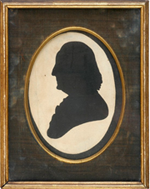
Silhouette of Franklin, Embossed Stamp below with "Peales Museum" Under a Spread Eagle.

Silhouette
of Philip Syng Jr.
On March 14, 1752, two months after his commission to create a silver inkstand for the Pennsylvania State House (Independence Hall), a bell that Philip Syng had ordered from London arrived in Philadelphia. This bell was to be shared by the Union Fire Company that he and Franklin had founded, and, the Hand-In-Hand Fire Company. With nowhere to hang the bell, Franklin, Syng and their fellow trustees agreed that the bell would now also be shared with the Academy and hung in a steeple that would be added to the Academy's "New Building". There, it would sound fire alarms and "answer the purpose of the Academy in giving Notice to the Scholars of the Hours of Meeting." After a long and stormy history of ownership, the Academy Bell was returned to the University of Pennsylvania in 1945. Again without a belfry, it is today displayed in the University of Pennsylvania's Van Pelt-Deitrich Library.
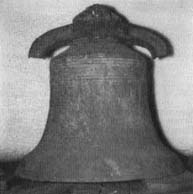
University of Pennsylvania's Academy Bell
What had been established as the Academy of Philadelphia, would be known as the College of Philadelphia from 1755 to 1779. Under the title of the College of Philadelphia, the first Medical School in the American Colonies was established. Dr. John Morgan, a member of the Academy's first graduating class, after returning from his "Grand Tour" of Europe with his friend Samuel Powel, organized with William Shippen Jr. a medical faculty to serve at the College of Philadelphia in 1765. With the addition of Morgan and Shippen's Medical School to the College of Philadelphia, it became America's first university, if not yet by name.
The College's medical lectures were held in Surgeon's Hall on Fifth Street near Walnut Street, rather than the Arch Street campus. Doctors' Morgan and Shippen had introduced two important elements to this medical school; it would be part of an institution of higher learning, and, supplement medical lectures with bedside teaching. Pennsylvania Hospital would provide the hands on location for the College of Philadelphia's students.
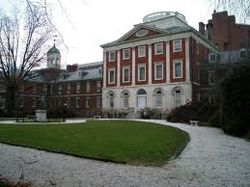
Pennsylvania Hospital
Fourteen years before the College of Philadelphia, Pennsylvania Hospital had been founded by Dr. Thomas Bond and Benjamin Franklin. Silversmith Philip Syng, as he did with all of Franklin's creations, also served as a founding trustee of Pennsylvania Hospital.
With the political turmoil of the American Revolution at a high point, the state of Pennsylvania seized the College of Philadelphia in 1779 due to its being viewed by the revolutionary state government as a Tory bastion. The state transformed the College of Philadelphia into, the University of the State of Pennsylvania, creating both America's first state school and America's first designated "University." Twelve years later, the state legislature issued a new charter returning the University to non-state ownership as the University of Pennsylvania.
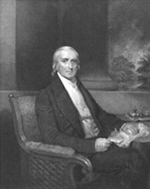
Dr. Physick painted by Henri Inman for the medical class of The University of Penn
Eighty-two year old silversmith Philip Syng lived to see his grandson, Philip Syng Physick, graduate as valedictorian of the University of the State of Pennsylvania's class of 1785. Like his grandfather, young Physick was known to be good with his hands. Physick wanted to follow in Philip Syng's footsteps and become a silversmith. However, Philip's father had other ideas and brought him to London to study under the famous Dr. John Hunter.
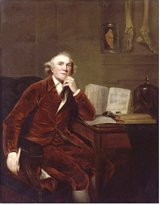
John Hunter painted by his friend Sir Joshua Reynolds, 1786
Known as "The Father of Modern Surgery," John Hunter was the first to introduce the scientific approach to surgery and medicine. Dr. Hunter's second most favorite student, Philip Syng Physick was the first American to hold the prestigious Chair of Surgery at St. George's Hospital in London.
Despite Dr. John Hunter's pleas, Dr. Physick returned to Philadelphia in 1792. In Philadelphia Physick would introduce Dr. Hunter's ideas and practices to future generations of American surgeons. Holding the first Chair of Surgery in an American medical school, Dr. Philip Syng Physick was in his lifetime called, "Father of American Surgery." Using skills learned from his grandfather Philip Syng, Dr. Physick would invent instruments still used today by surgeons, doctors, dentist and optometrist.
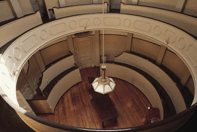
Pennsylvania Hospital's
"Dreaded Circular Room"
1n 1804 with the completion of Pennsylvania Hospital's center section, the first amphitheatre operating room in America was built on the top floor under a skylight window to accommodate Dr. Philip Sing Physick's popular lectures. In this famous oval room he performed operations and lectured to his students in the gallery. His lectures could also be witnessed by up to one hundred and fifty people from the general public. The public could purchase tickets to sit in the balcony. The sale of these tickets helped defer the cost of the free care given to the poor and homeless for which the hospital had been founded, and was serving.
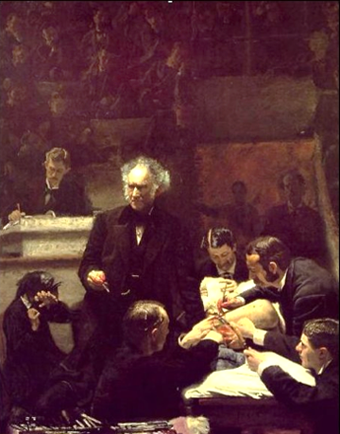
The Gross Clinic by Thomas Eakins, 1875
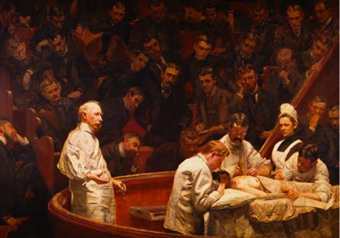
The Agnew Clinic by Thomas Eakins, 1889
Following in Physick's footsteps, the University of Pennsylvania would continue to lead the way in the training of medical students and surgeons. Among these was David Hayes Agnew (1818–1892), a greatly respected anatomist and surgeon holding positions at Pennsylvania Hospital between 1865-1871, and again from 1877 until 1884. Students of the University of Pennsylvania School of Medicine, in honor of Dr. Agnew's retirement, commissioned Thomas Eakins to create another masterpiece, the Agnew Clinic. Similar to his Gross Clinic painted fourteen years before, Eakin's Agnew Clinic shows the advances in medicine made during the intervening period between these two paintings.
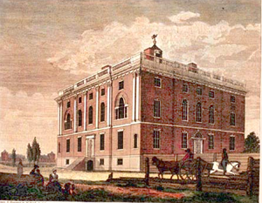
The House intended for the President of the United States, Ninth Street, engraving by Russell & Thomas Birch, in 1801.
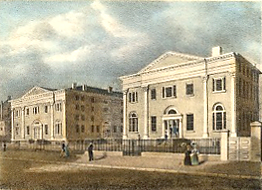
Twin Buildings
Twin University of Pennsylvania Strickland Buildings,
J.T. Bowen color print, 1842
The University of Pennsylvania, The College of Philadelphia, and The Academy of Philadelphia and Charitable School, had all been housed in the "New Building" at Fourth and Arch Streets from 1751 through 1801. In that year, The University moved to the "President's House" at Ninth and Market Streets. Having been built in 1790 as the intended residence for the U.S. President, both Presidents' Washington and Adams declined to occupy this mansion. Standing empty, the University of Pennsylvania would renovate it for their use in 1801. It would be demolished in 1828 for the erection of twin marble-trimmed brick buildings designed by William Strickland. The College and the Faculty of Medicine of the University now had separate buildings on Ninth Street, identical in facade, but arranged internally for each department's specific needs. The Academy's Charity School continued at the Fourth Street site until 1877.
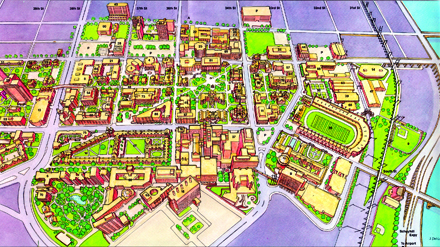
Illustrated view of University of Pennsylvania Main Campus,
J. Del Conner, 1981
Expanding student enrollment and changing curriculum led the University in 1872 to move its campus to spacious West Philadelphia. Syng and Physick descendent J. Del Conner in 1979 had the pleasure of creating a birds-eye-view illustration of this campus for use in University's walking tour maps, publications and displays. Mr. Conner's map of the University has been updated internally since 1995: http://mappery.com/map-of/University-of-Pennsylvania-3D-campus-map. A similar map of the University's Morris Arboretum was drawn by Mr. Conner in 1984 and updated through 2005.
Illustrated view of University of Pennsylvania's Morris Arboretum,
J. Del Conner, 1981
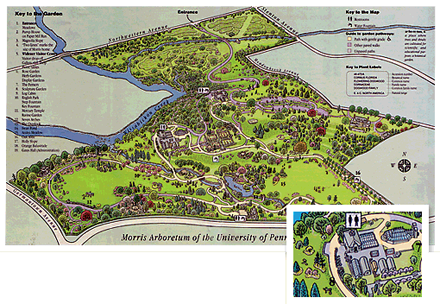
In 1997, Pennsylvania Hospital's Board of Managers made the decision to merge with the University of Pennsylvania Health System reestablishing a bond that spanned centuries. The large health system helps to support the formerly stand-alone Pennsylvania Hospital with its network of resources.
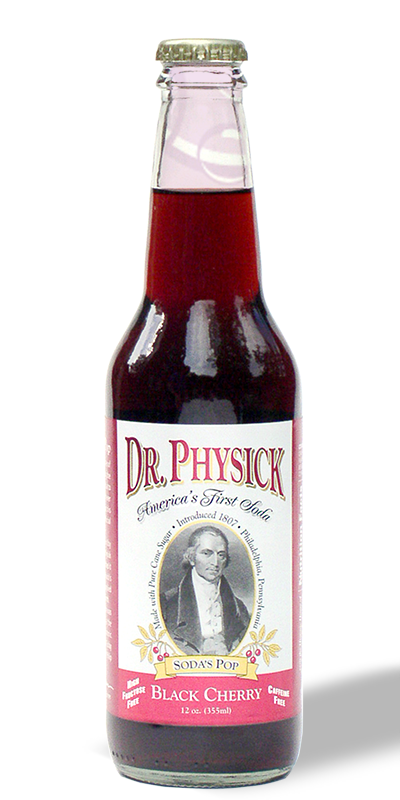

 City Tavern's Chef Walter Steib's tour of Physick House
City Tavern's Chef Walter Steib's tour of Physick House 